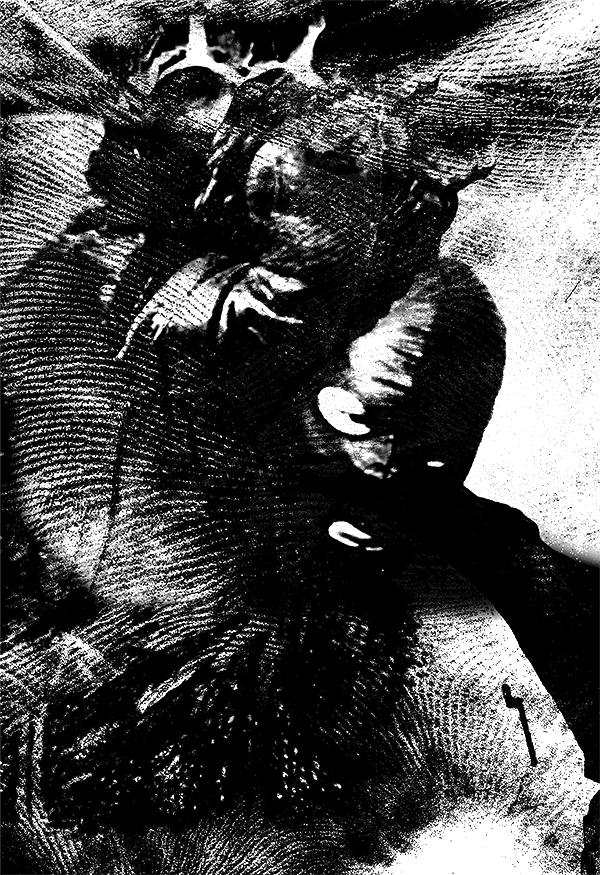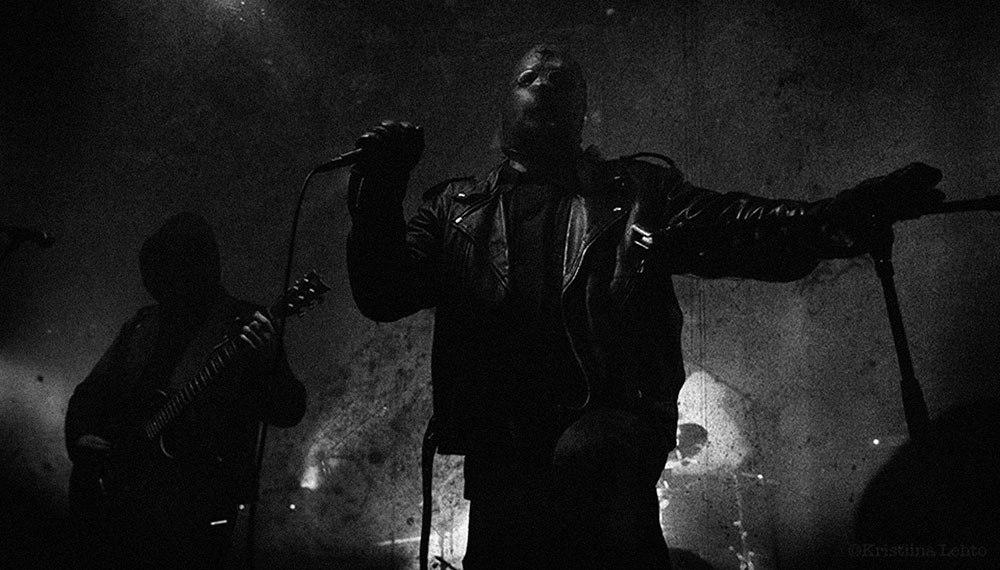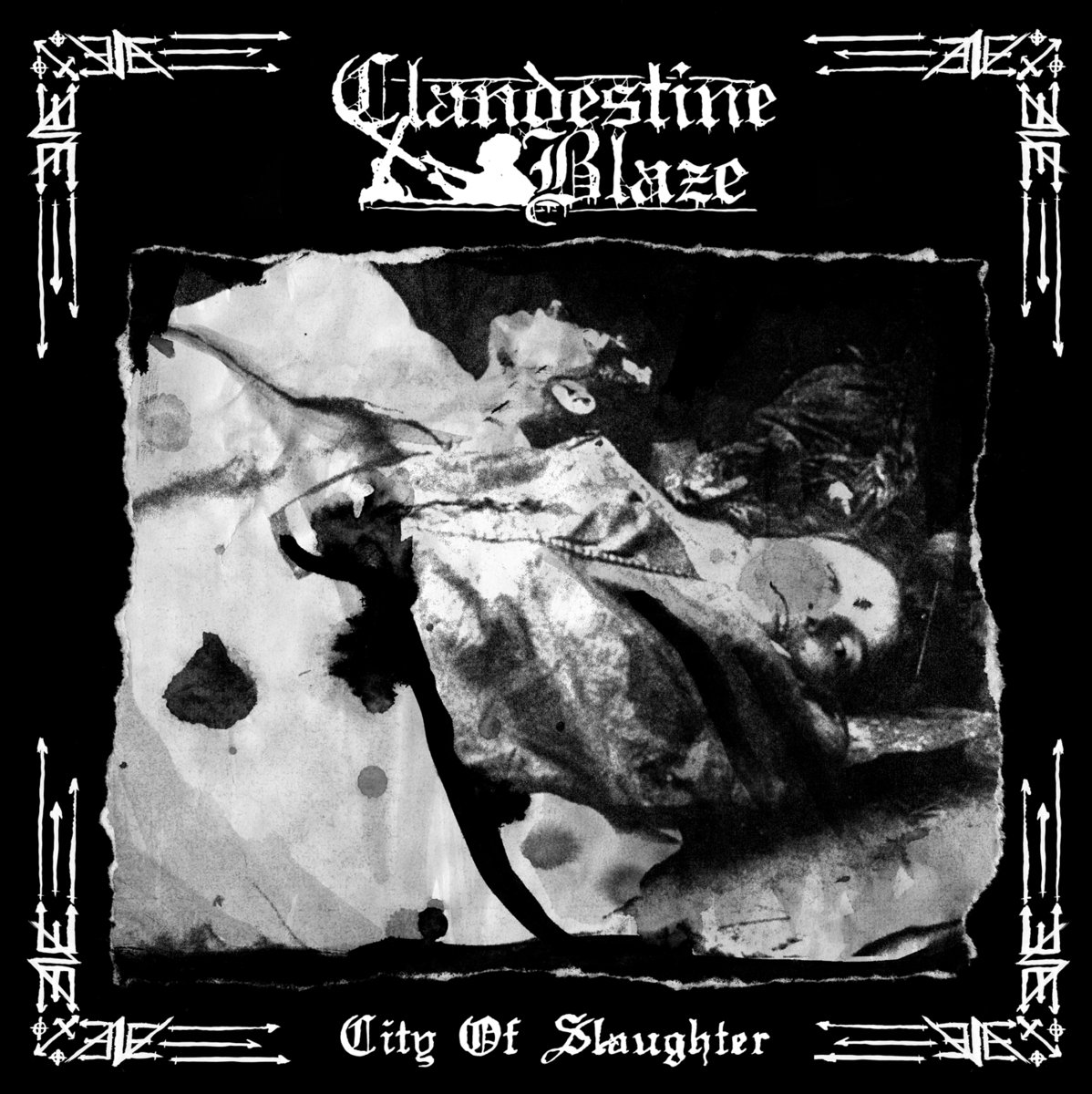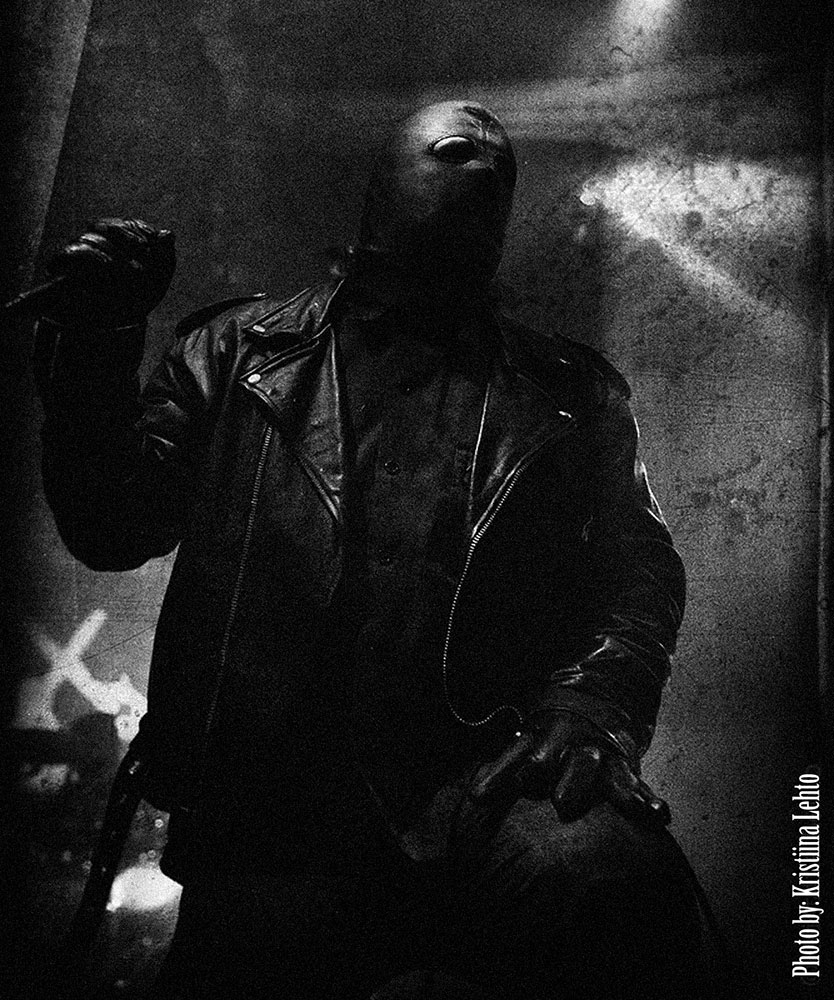Clandestine Blaze|Northern Heritage
2017-05-17
by Niklas Göransson
A conversation with multi-faceted Finnish counterculture artist and entrepreneur Mikko Aspa, no doubt known to the readership primarily through his work with Clandestine Blaze and Northern Heritage.
This article can also be found in Bardo Archivology Vol. 1, a printed anthology with selected features from the online archive. Additional content includes IRKALLIAN ORACLE, AOSOTH, NIFELHEIM, UNPURE, MORBID, ABIGOR, NUMINOUS, RIDE FOR REVENGE, AKITSA, MALIGN, NORDVIS, ARMAGEDDA, EHLDER, and DEATHSPELL OMEGA – all presented in ambitious aesthetics with plenty of custom artwork. More information here.

– “City of Slaughter” is not a concept album. Each track has its own theme; topics CLANDESTINE BLAZE from time to time dealt with in slightly different forms. The title track speaks of the birthing moment of modern genocide, while “Century of Firepower” observes the introduction of machine guns to contemporary warfare – instantly stripping concepts such as individual heroism of all value. “Archeopsychic Fear” and “Remembrance of a Ruin” deal with specific qualities of the human consciousness where primal urges collide with conflicting ideals.
February 2017 saw the release of CLANDESTINE BLAZE’s ninth album, “City of Slaughter”, as the hundredth release of Northern Heritage – Mikko’s black metal label.
– My intention from the very beginning was to create a nastier, darker and more distorted album. The desire for ugliness was partly of internal origin but also a reaction to the abundance of clean and sophisticated black metal currently flooding the genre.
Some of the most recent song structures are rather different compared to the older work. Mikko says his early material was largely written to sound deliberately ’bare bones’.
– There were rarely any intentions of writing compelling or catchy songs, but this attitude changed over the years. Most of the riffs were composed in a handful of sessions between live gigs in Belgium and Poland.
While CLANDESTINE BLAZE as a live act is a fairly recent phenomenon, Mikko has been performing in concert – both as session member of black metal bands and with his own projects – for almost twenty years.
– The older material was so simple and monotonous that I doubt its efficacy in any other setting than solo-listening from a record with a specific sound quality. But over the years, new material began evolving in ways which might just work in a live setting.
Mikko adds that it was never his intention to create stage-oriented music, but rather something livelier and more complex than the ’dead and rotten simplicity’ of younger days.
– Since I am the band’s sole musician, CLANDESTINE BLAZE does not rehearse. There was never a necessity to memorise either riffs or songs and I had my doubts whether I could even remember a full set’s worth of lyrics. Eventually it was playing live with one of my other bands, VAPAUDENRISTI, that would prove me wrong. Then, for their first gig in Finland, MGŁA wanted to play two CLANDESTINE BLAZE tracks with me on vocals. It felt very natural on stage so plans advanced into three full-length gigs with this line-up. Future is currently undecided.
Your stage attire – with the mask and so forth, is this simply to fit in with your live musicians or is there some kind of underlying ego-cleaving purpose?
– The clothes I wear on stage is how I usually dress. That mask has been in use since “Fist of the Northern Destroyer” (2002) as well as in everything else, from my power electronics band GRUNT to various film projects. While used to guard human identity, its real function is not to hide but to reveal.

Mikko’s backing ensemble, MGŁA, is a prominent Polish black metal band who began their career on Northern Heritage without a single recording to their name. In 2005, they were invited to participate on a split album called “Crushing the Holy Trinity” featuring, among others, CLANDESTINE BLAZE and DEATHSPELL OMEGA. Ten years and three albums later, the collaboration remains intact.
– I was in touch with M before MGŁA even existed. He used to have power electronics and dark ambient projects back in the 90s and also edited a black metal ‘zine. I was among the few people to hear his earliest instrumental recordings.
While the demos in question might not necessarily warrant public release, Mikko detected in them a quality which is now being perfected in MGŁA – what he calls an ’undisputed mastery of eerie melody and atmosphere’.
– I could sense the potential, listening to those raw and primitive bedroom recordings. This, combined with our correspondence, convinced me that I was dealing with someone exceptional who would rise far above the rabble. So I signed them to my label despite there being very little to show, merely by gut feeling of important things to come.
If there’s one thing Mikko has learned over the years, especially when it comes to fledgling artists, it’s paying attention to his intestinal intuition. With exception of a handful releases by established names – ILDJARN and DIABOLI come to mind – most of Northern Heritage’s signings have been bands in the very beginning of their careers.
– SATANIC WARMASTER, BAPTISM, DEATHSPELL OMEGA, and so on – bands who would go on to become globally acknowledged names but were originally signed to Northern Heritage in times when not many people knew them. Regardless of success, I’m proud over all my signings. Take UNCREATION’S DAWN, NUMINOUS, PHLEGEIN, BLOODHAMMER and so on. Despite relative obscurity, there’s an inexplicable quality elevating them above and beyond the norm. In times like this, it’s especially impressive to manifest a very different black metal spirit than the currently prevailing one. Certain elitist and hierarchical undertones are a necessity.
One could certainly argue that the genre has always been infused with a strong element of both elitism and hierarchy – and as silly as this ’true and false’ business might sound today, black metal would never have become what it did in the 90s without it.
– I firmly believe much of the original spirit was a result of arrogance combined with the will to greatness. Discontent with standing equal to the masses, many bands had an internal burning spirit to create coupled with irrationally perceived feelings of their own importance. All of this merged as a counter-reaction to the surrounding world – and, even more so, the remaining scene. Taking a long, hard look at the genre today, one should be horrified to learn which acts currently enjoy popularity. Hyped up and press-friendly black metal bands are ’false’ by their very definition. There’s also an ever-growing number of these ’socially aware’ parasites, seemingly clueless of what they’re dealing with. Combine that with the alarming number of people wasting energy on giving them attention, even for sake of a quick laugh.
Mikko stresses how everyone needs to accept the fact that countercultures by default pit the performer against the grain.
– When you wade against the current, you’re bound to have interactions with people drifting in the opposite direction. Countercultural black metal is, quite logically, on a collision course with the mainstream music business; bigger media, festivals, mainstream networks, mundane music fans, and all this mingling on social media. Elitism is the integral principle behind all gatherings of peers brought together by qualities which separate them from all others. One needs not belong to the aristocracy to appreciate its value. To support, cultivate, and perhaps aim for it. The elite is in no need of converting aimless drifters who fail to grasp why a select few manage to tread different paths, yet it’s good to see able ones have some sort of revelation and at least attempt to make the turn.

Unless I’m entirely misreading certain lyrics, “The Voice of our Mythical Past” for instance, it sounds as if Mikko genuinely wishes to introduce some manner of subjectively positive societal change.
– There are quotation marks in this lyric, which is to indicate the words coming from a different author. Of course, these excerpts have been selected with a clear purpose. This track represents a nobler aspect of CLANDESTINE BLAZE, which has been present in previous works but most visible since the fifth album, “Church of Atrocity” from 2006. Therefore, the music is more triumphant than rotten or hostile.
Let’s say that by some miracle, Mikko’s personal worldview instigated the next major paradigm shift – rendering him in sudden residence under societal policies he finds generally sympathetic. The question is whether he’d be able to keep thriving artistically, no longer in countercultural opposition. Or perhaps he’d be happier as an outcast among detestable surroundings, in a kind of mutually contemptuous equilibrium.
– Strife is what defines us as humans. Even if current social policies or personal life in general would be sensible, it’s not the full story. Besides rhetorical and physical conflict, most often there’s also a never-ending internal struggle. Like, for example, between selfish goals and that which lies beyond. One can always question if life should be aimed at personal happiness or something higher? As expressed in “Harmony of Struggle” (2013), I don’t believe there is existence without conflict. Many may contend the necessity of state-level warfare but one cannot deny struggle as a key element to life itself. All societies must acknowledge their own fragility and not seek goodwill in fellow men. Even less for the assumed benevolence of ’the others’.
Adhering to those principles, warfare would be a requisite in order for so-called civilised society to function properly. Not necessarily its actual execution per se – rather a threat of it, or more importantly, the memory. Comparing the nations Mikko and I reside in, it could indeed be stated with some certainty that societies develop inversely if one of them makes war and bleeds on its own soil within a generation, whereas the other sees no armed conflict for over two centuries. Which outcome is preferable is obviously an individual preference but it would be hard to refute a notable difference.
– I’m not suicidal, neither individually nor collectively. Self-preservation leads to several simple conclusions. If one is to observe the state of Swedish society, it’s a collective suicidal urge on levels of mental disease. Finland may be few steps behind, where the course is still reversible.
Mikko points out that his thematic foundation for songs such as “The Voice of Our Mythical Past” far transcends the simplified narrative outlined in its lyrics.
– They focus exclusively on the blatantly anti-Christian side of it, whereas the underlying concept runs significantly deeper, offering an alternative vision for both the Abrahamitic plague as well as modern individualism.
This was something I was getting to; at times, I detect in CLANDESTINE BLAZE’s lyrics what appears to be a reluctant longing for some manner of primordial tribal spirituality. As if he’s too much of a cynical bastard to actually allow himself to believe in anything, but almost wishes for the certainty of something profound.
– Primordial tribal spirituality is not the correct expression. Also, I don’t believe higher powers are there to be relied upon. Really, the only thing that can be reliably depended on is their utter indifference towards your emotions and wishes. But I don’t reject spirituality, despite the fact that it’s often used for matters which can be fully rationalised or seem to be mere materialistic concepts with a pretentious twist.

Do you find people who explore their spiritual side more inclined towards lethargy?
– See the ABIGOR interview previously featured in Bardo Methodology. It would indeed appear as if growing numbers are busy becoming ’enlightened’. But enlightened in what way? I feel that to an increasing extent, the ’spiritual’ is simply used as a cop-out for apathy in one’s current existence, an inability to take a stand. There is no validity to the numinous unless it has a demonstrative impact on one’s lifestyle and world-view. What is this tourist attraction to glimpse on ’the other side’ if your life continues to drift unchanged, stuck in the same low levels of mundane existence? What use is ’higher knowledge’ if one appears unable to use it for anything? Or be truly affected by it?
Though in principle sympathetic to the search for gnosis, Mikko’s tolerance ends when it’s intrinsically linked to ‘pacifism, pseudo-exotic and predetermined humanist ideals’. Unsurprisingly, he finds himself leaning towards the opposite end of the philosophical spectrum.
– While the mystical experience might be somewhat cheapened by demanding practical results, I feel the criticism is warranted here. Especially since most of these attributes appear to be empty aesthetics clearly used as cheap selling points and trendy gimmicks. Many subscribe to this hypothesis of all mystical traditions sharing a common core, and then incorporate parts of it in their own context – which is mostly fine. In others, it appears to instil a situation of ’identity shopping’ which I don’t see as especially productive. You know, fucking trips to India in search of themselves, adaptation of an alien identity in replacement of their own. This often comes down to a quest for redemption, a desperate hope of relief through rebirth. One could consider it the typical ’sick soul’ syndrome of people who have formerly hit rock bottom. Whether it’s diminishing of youthful energy or overall pussyfication in the black metal zeitgeist, results would seem to be growing numbers accepting these hypothesises as some kind of salvation.
How then does one accomplish divine transformation from dull reality?
– Certainly not by passive daydreaming, but rather living the myth of ideals and so enabling them to become real. From the Western philosophical perspective, enlightenment means attaining a higher level of wisdom and knowledge; I stand entirely unopposed to this. What I reject, on the other hand, is New Age aesthetics and pretensions reeking of escapist mentality. I dismiss any teaching which primarily involves passivity, pacifism and other vegetative mindsets. I firmly believe in the seamless union of material and spirit, this and the beyond. Not just one or the other, but both. It’s an all-inclusive world-view and reality.

This is part I of this conversation – the second can be found in Bardo Methodology #2. The issue features conversations with Bobby BeauSoleil, REBIRTH OF NEFAST, Reverend Kriss Hades (SADISTIK EXEKUTION), MANILLA ROAD, ABIGOR, ATLANTEAN KODEX, MASTER’S HAMMER, NIGHTBRINGER, RAM, IMPALED NAZARENE, PHURPA, and INQUISITION.



